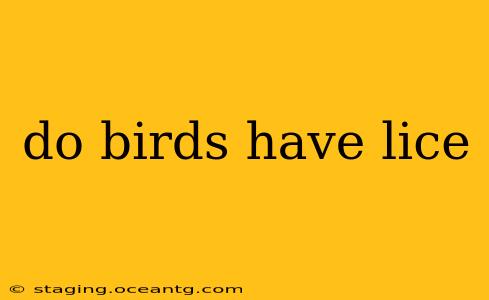Do Birds Have Lice? A Deep Dive into Avian Parasites
Yes, birds absolutely can and do get lice. While the image of a fluffy chick might seem far removed from the idea of parasites, the reality is that many bird species are susceptible to various types of lice, which are specialized to live on specific bird hosts. These aren't the same lice that infest humans; avian lice are highly adapted to their feathered hosts and can't typically survive on mammals. Understanding these parasites and their impact on bird health is crucial for bird enthusiasts and conservationists alike.
What Kinds of Lice Infect Birds?
Several families of lice infest birds, belonging to the order Phthiraptera. These tiny insects are wingless and highly specialized to their hosts. They differ significantly from the lice that affect humans and other mammals. The lice found on birds are further divided into two main suborders: Amblycera and Ischnocera. Each suborder contains species with unique characteristics and feeding habits. Some species are highly specialized to specific bird species or even specific feather types.
How Do Birds Get Lice?
Lice are typically transmitted through direct contact between birds. This can happen during nesting, mating, or even simply being in close proximity to an infested bird. Young birds, particularly chicks in the nest, are often at higher risk of infestation because of their close contact with each other and their parents. Adult birds can also acquire lice through contact with infected nests or other contaminated surfaces. Nests built in close proximity to one another, especially in densely populated bird colonies, increase the chances of lice transmission.
What Are the Signs of Lice in Birds?
Identifying a bird lice infestation can be tricky, especially in wild birds. However, some common signs to watch out for include:
- Feather loss or damage: Lice feeding can cause localized feather damage, resulting in patchy feather loss or a ruffled appearance. This is particularly noticeable around the base of the feathers, where lice tend to cluster.
- Restlessness or excessive preening: Infested birds often exhibit increased preening behavior as they attempt to remove the parasites. This can lead to irritation and feather damage.
- Skin irritation: Lice bites can cause irritation and inflammation of the bird's skin, sometimes leading to scabbing or lesions.
- Weakness or weight loss: In severe cases, a large lice infestation can weaken the bird, affecting its ability to forage for food and leading to weight loss.
It's crucial to remember that these symptoms can also indicate other health problems, so it's essential to seek veterinary advice if you suspect a lice infestation in your pet bird.
How Are Bird Lice Treated?
Treating bird lice depends on the severity of the infestation and the species of bird affected. For pet birds, a veterinarian can recommend appropriate treatments, which may include topical insecticides or medicated baths. It's critical to follow the veterinarian's instructions carefully to ensure both the bird's safety and the effectiveness of the treatment. For wild birds, treatment is rarely feasible and often not recommended due to the difficulty of administering medication and the potential negative impact on the surrounding environment.
Can Lice From Birds Infect Humans?
No, the lice that infect birds are highly specialized and cannot survive on humans. There is no risk of transmission from birds to humans.
How Can I Prevent Bird Lice in My Pet Bird?
Maintaining good hygiene in your pet bird's cage is crucial to prevent lice infestations. Regular cleaning, disinfection, and providing fresh bedding can significantly reduce the risk. Quarantining new birds before introducing them to existing birds is also a critical preventative measure.
In conclusion, while many bird species are susceptible to lice infestations, understanding the types of lice involved, the signs of infestation, and appropriate treatment methods allows for better management and care of both wild and pet birds. Remember that early detection and proper intervention can significantly impact a bird's health and well-being.
